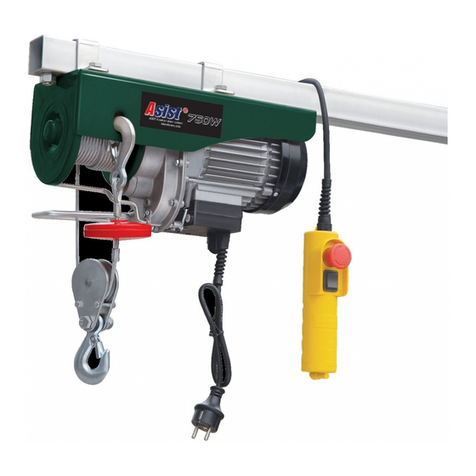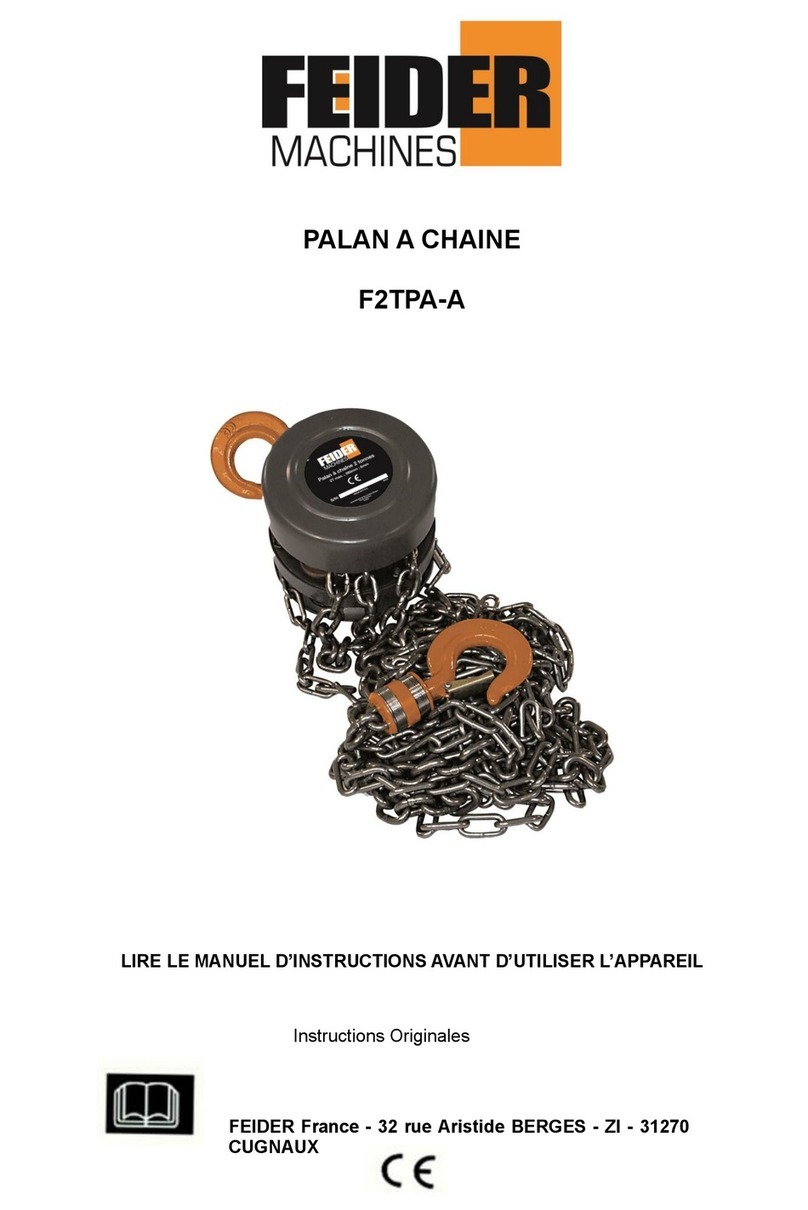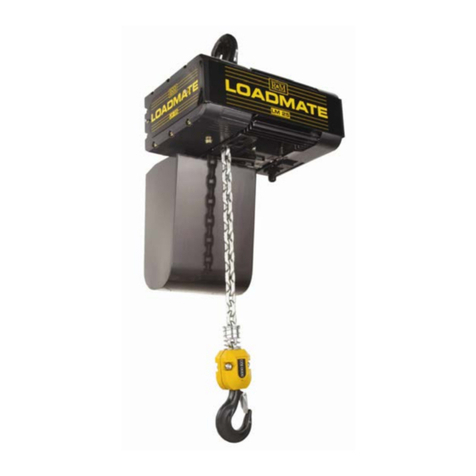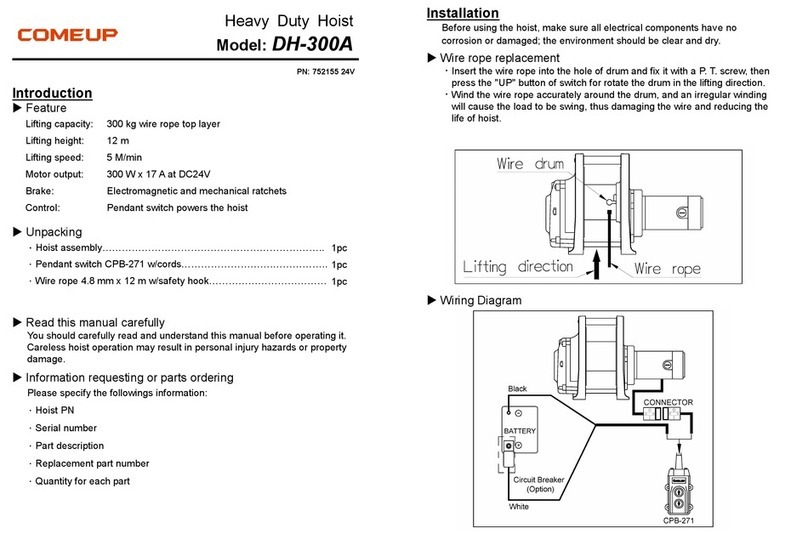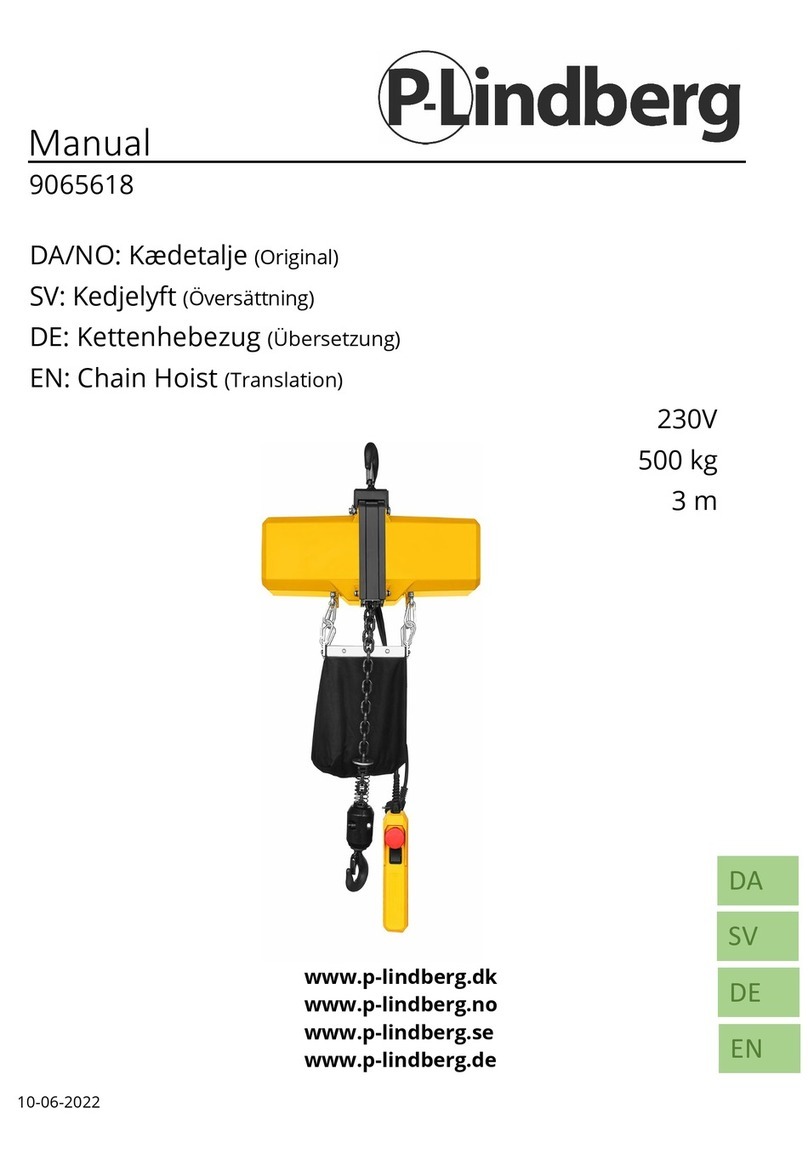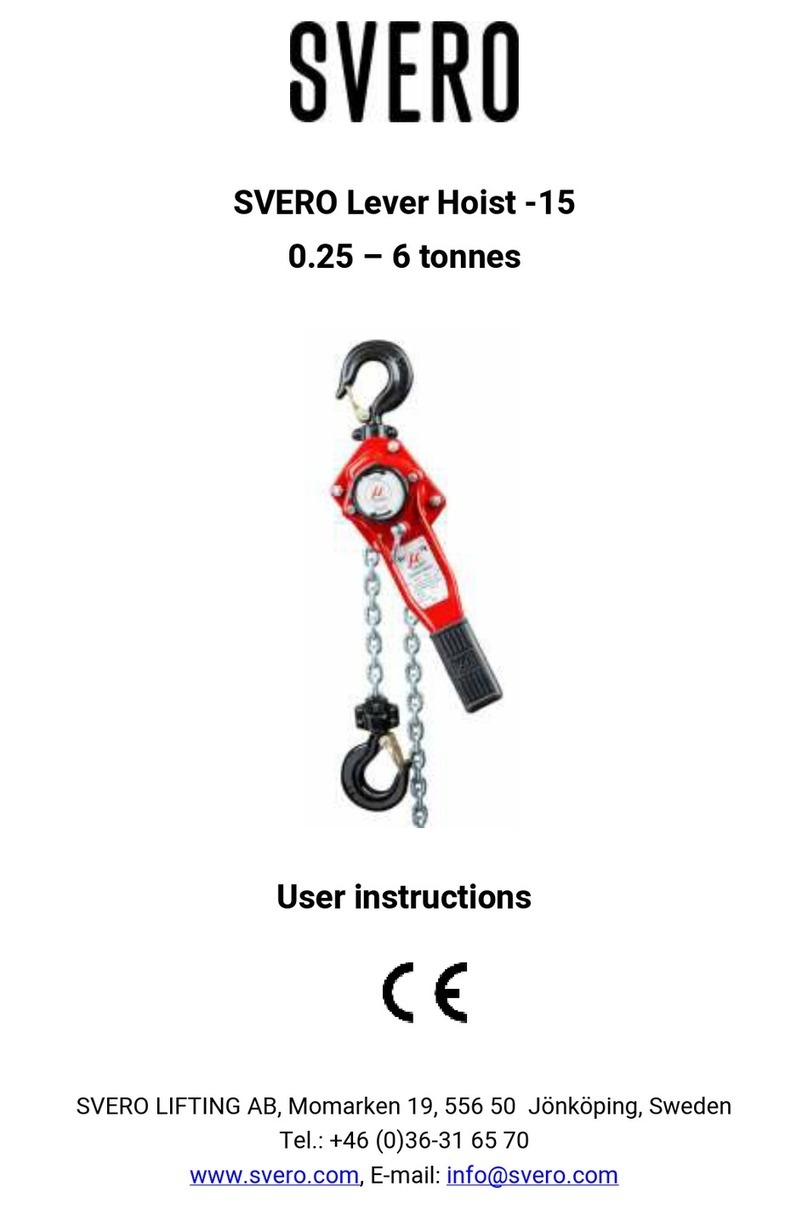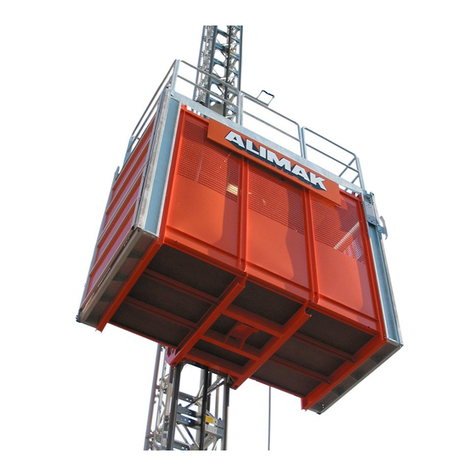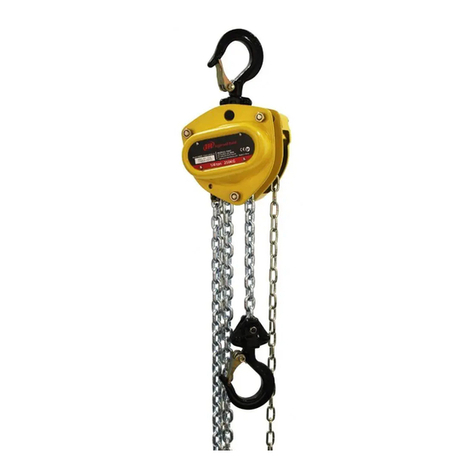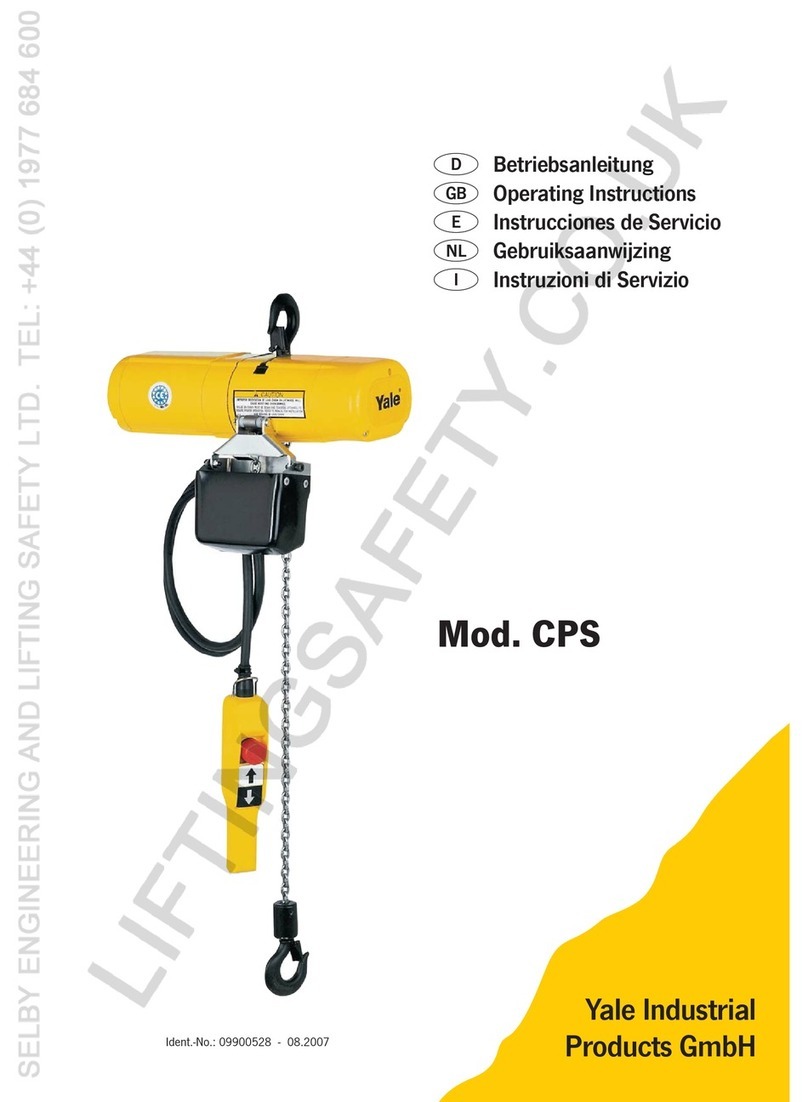Nihon Bisoh BISOMAC210 User manual

NIHON BISOH CO., LTD.
BISOMAC210
Specifications for North America 3P model
Electric Traction Hoist
Operator’s Manual
[with Overload Detection Device]

IMPORTANT SAFETY INSTRUCTIONS
READ ALL INSTRUCTIONS BEFORE USING THIS EQUIPMENT.
Any operation in violation of these instructions may result in bodily injury or death.
WARNING
+ All operators must read and completely understand this manual.
+ All operators must be thoroughly trained and certified in the use of the equipment, its
operational and safety features.
+ Only authorized and physically fit operators shall operate the equipment.
+ At the start of each work shift, daily test must be performed to ensure correct operation.
+ Any operations in violation of these instructions is operator’s own risk and may result in serious
injuries.
+ Keep this manual with the hoist at all time.
+ Use only spare parts and steel wire rope recommended by NIHON BISOH.
+ Use only machinery or incorporated component, which MUST COMPLY with UL1323, CAN/CSA
Z271-10 and national, regional, or local implementing.
+ Installation, dismantling and use of suspended scaffold shall be in accordance with Code of
Safe Practices (COSP) for Adjustable Suspended Scaffold which implemented by Scaffolding,
Shoring and Forming Institute (SSFI) and Scaffold & Access Industry Association (SAIA).
+ It is the responsibility of the user of this hoist to determine that this hoist is suitable to be used in
conjunction with any other equipment. The user must also determine that this hoist and other
components used will be in strict conformity with the provisions of Federal, State, National and
local ordinances and regulations.
Manufacturer: NIHON BISOH CO., LTD.

TABLE OF CONTENTS
0. READ BEFORE USE ꞏꞏꞏꞏꞏꞏꞏꞏꞏꞏꞏꞏꞏꞏꞏꞏꞏꞏꞏꞏꞏꞏꞏꞏꞏꞏꞏꞏꞏꞏꞏꞏꞏꞏꞏꞏꞏꞏꞏꞏꞏꞏꞏꞏꞏꞏꞏꞏꞏꞏꞏꞏꞏꞏꞏꞏꞏꞏꞏꞏꞏꞏꞏꞏꞏꞏꞏꞏꞏꞏꞏꞏꞏꞏꞏꞏꞏꞏꞏꞏꞏꞏꞏꞏꞏꞏꞏꞏ1
1. FOR SAFE USEꞏꞏꞏꞏꞏꞏꞏꞏꞏꞏꞏꞏꞏꞏꞏꞏꞏꞏꞏꞏꞏꞏꞏꞏꞏꞏꞏꞏꞏꞏꞏꞏꞏꞏꞏꞏꞏꞏꞏꞏꞏꞏꞏꞏꞏꞏꞏꞏꞏꞏꞏꞏꞏꞏꞏꞏꞏꞏꞏꞏꞏꞏꞏꞏꞏꞏꞏꞏꞏꞏꞏꞏꞏꞏꞏꞏꞏꞏꞏꞏꞏꞏꞏꞏꞏꞏꞏꞏꞏꞏꞏꞏꞏꞏꞏ5
1.1 General ꞏꞏꞏꞏꞏꞏꞏꞏꞏꞏꞏꞏꞏꞏꞏꞏꞏꞏꞏꞏꞏꞏꞏꞏꞏꞏꞏꞏꞏꞏꞏꞏꞏꞏꞏꞏꞏꞏꞏꞏꞏꞏꞏꞏꞏꞏꞏꞏꞏꞏꞏꞏꞏꞏꞏꞏꞏꞏꞏꞏꞏꞏꞏꞏꞏꞏꞏꞏꞏꞏꞏꞏꞏꞏꞏꞏꞏꞏꞏꞏꞏꞏꞏꞏꞏꞏꞏꞏꞏꞏꞏꞏꞏꞏꞏꞏꞏꞏꞏꞏ5
1.2 Maintenance ꞏꞏꞏꞏꞏꞏꞏꞏꞏꞏꞏꞏꞏꞏꞏꞏꞏꞏꞏꞏꞏꞏꞏꞏꞏꞏꞏꞏꞏꞏꞏꞏꞏꞏꞏꞏꞏꞏꞏꞏꞏꞏꞏꞏꞏꞏꞏꞏꞏꞏꞏꞏꞏꞏꞏꞏꞏꞏꞏꞏꞏꞏꞏꞏꞏꞏꞏꞏꞏꞏꞏꞏꞏꞏꞏꞏꞏꞏꞏꞏꞏꞏꞏꞏꞏꞏꞏꞏꞏꞏꞏꞏꞏ6
1.3 Hazard Symbolsꞏꞏꞏꞏꞏꞏꞏꞏꞏꞏꞏꞏꞏꞏꞏꞏꞏꞏꞏꞏꞏꞏꞏꞏꞏꞏꞏꞏꞏꞏꞏꞏꞏꞏꞏꞏꞏꞏꞏꞏꞏꞏꞏꞏꞏꞏꞏꞏꞏꞏꞏꞏꞏꞏꞏꞏꞏꞏꞏꞏꞏꞏꞏꞏꞏꞏꞏꞏꞏꞏꞏꞏꞏꞏꞏꞏꞏꞏꞏꞏꞏꞏꞏꞏꞏꞏꞏꞏꞏ6
2. SPECIFICATIONSꞏꞏꞏꞏꞏꞏꞏꞏꞏꞏꞏꞏꞏꞏꞏꞏꞏꞏꞏꞏꞏꞏꞏꞏꞏꞏꞏꞏꞏꞏꞏꞏꞏꞏꞏꞏꞏꞏꞏꞏꞏꞏꞏꞏꞏꞏꞏꞏꞏꞏꞏꞏꞏꞏꞏꞏꞏꞏꞏꞏꞏꞏꞏꞏꞏꞏꞏꞏꞏꞏꞏꞏꞏꞏꞏꞏꞏꞏꞏꞏꞏꞏꞏꞏꞏꞏꞏꞏꞏꞏꞏꞏ13
2.1 BISOMAC308 ꞏꞏꞏꞏꞏꞏꞏꞏꞏꞏꞏꞏꞏꞏꞏꞏꞏꞏꞏꞏꞏꞏꞏꞏꞏꞏꞏꞏꞏꞏꞏꞏꞏꞏꞏꞏꞏꞏꞏꞏꞏꞏꞏꞏꞏꞏꞏꞏꞏꞏꞏꞏꞏꞏꞏꞏꞏꞏꞏꞏꞏꞏꞏꞏꞏꞏꞏꞏꞏꞏꞏꞏꞏꞏꞏꞏꞏꞏꞏꞏꞏꞏꞏꞏꞏꞏꞏꞏꞏꞏꞏꞏ13
2.2 BISOLOCK ꞏꞏꞏꞏꞏꞏꞏꞏꞏꞏꞏꞏꞏꞏꞏꞏꞏꞏꞏꞏꞏꞏꞏꞏꞏꞏꞏꞏꞏꞏꞏꞏꞏꞏꞏꞏꞏꞏꞏꞏꞏꞏꞏꞏꞏꞏꞏꞏꞏꞏꞏꞏꞏꞏꞏꞏꞏꞏꞏꞏꞏꞏꞏꞏꞏꞏꞏꞏꞏꞏꞏꞏꞏꞏꞏꞏꞏꞏꞏꞏꞏꞏꞏꞏꞏꞏꞏꞏꞏꞏꞏꞏꞏꞏꞏ14
2.3 BISOLOAD ꞏꞏꞏꞏꞏꞏꞏꞏꞏꞏꞏꞏꞏꞏꞏꞏꞏꞏꞏꞏꞏꞏꞏꞏꞏꞏꞏꞏꞏꞏꞏꞏꞏꞏꞏꞏꞏꞏꞏꞏꞏꞏꞏꞏꞏꞏꞏꞏꞏꞏꞏꞏꞏꞏꞏꞏꞏꞏꞏꞏꞏꞏꞏꞏꞏꞏꞏꞏꞏꞏꞏꞏꞏꞏꞏꞏꞏꞏꞏꞏꞏꞏꞏꞏꞏꞏꞏꞏꞏꞏꞏꞏꞏꞏꞏ14
2.4 Wire Ropeꞏꞏꞏꞏꞏꞏꞏꞏꞏꞏꞏꞏꞏꞏꞏꞏꞏꞏꞏꞏꞏꞏꞏꞏꞏꞏꞏꞏꞏꞏꞏꞏꞏꞏꞏꞏꞏꞏꞏꞏꞏꞏꞏꞏꞏꞏꞏꞏꞏꞏꞏꞏꞏꞏꞏꞏꞏꞏꞏꞏꞏꞏꞏꞏꞏꞏꞏꞏꞏꞏꞏꞏꞏꞏꞏꞏꞏꞏꞏꞏꞏꞏꞏꞏꞏꞏꞏꞏꞏꞏꞏꞏꞏꞏꞏꞏꞏ14
2.5 Power Cable ꞏꞏꞏꞏꞏꞏꞏꞏꞏꞏꞏꞏꞏꞏꞏꞏꞏꞏꞏꞏꞏꞏꞏꞏꞏꞏꞏꞏꞏꞏꞏꞏꞏꞏꞏꞏꞏꞏꞏꞏꞏꞏꞏꞏꞏꞏꞏꞏꞏꞏꞏꞏꞏꞏꞏꞏꞏꞏꞏꞏꞏꞏꞏꞏꞏꞏꞏꞏꞏꞏꞏꞏꞏꞏꞏꞏꞏꞏꞏꞏꞏꞏꞏꞏꞏꞏꞏꞏꞏꞏꞏꞏꞏ15
3. FUNCTION AND DESCRIPTION OF EACH COMPONENT ꞏꞏꞏꞏꞏꞏꞏꞏꞏꞏꞏꞏꞏꞏꞏꞏꞏꞏꞏꞏꞏꞏꞏꞏꞏꞏꞏꞏꞏꞏꞏꞏꞏꞏꞏꞏꞏꞏ16
3.1 BISOMAC210 TRACTION HOISTꞏꞏꞏꞏꞏꞏꞏꞏꞏꞏꞏꞏꞏꞏꞏꞏꞏꞏꞏꞏꞏꞏꞏꞏꞏꞏꞏꞏꞏꞏꞏꞏꞏꞏꞏꞏꞏꞏꞏꞏꞏꞏꞏꞏꞏꞏꞏꞏꞏꞏꞏꞏꞏꞏꞏꞏꞏꞏꞏꞏꞏꞏꞏꞏꞏꞏ16
3.2 BISOLOCK ꞏꞏꞏꞏꞏꞏꞏꞏꞏꞏꞏꞏꞏꞏꞏꞏꞏꞏꞏꞏꞏꞏꞏꞏꞏꞏꞏꞏꞏꞏꞏꞏꞏꞏꞏꞏꞏꞏꞏꞏꞏꞏꞏꞏꞏꞏꞏꞏꞏꞏꞏꞏꞏꞏꞏꞏꞏꞏꞏꞏꞏꞏꞏꞏꞏꞏꞏꞏꞏꞏꞏꞏꞏꞏꞏꞏꞏꞏꞏꞏꞏꞏꞏꞏꞏꞏꞏꞏꞏꞏꞏꞏꞏꞏꞏ19
3.3 BISOLOAD ꞏꞏꞏꞏꞏꞏꞏꞏꞏꞏꞏꞏꞏꞏꞏꞏꞏꞏꞏꞏꞏꞏꞏꞏꞏꞏꞏꞏꞏꞏꞏꞏꞏꞏꞏꞏꞏꞏꞏꞏꞏꞏꞏꞏꞏꞏꞏꞏꞏꞏꞏꞏꞏꞏꞏꞏꞏꞏꞏꞏꞏꞏꞏꞏꞏꞏꞏꞏꞏꞏꞏꞏꞏꞏꞏꞏꞏꞏꞏꞏꞏꞏꞏꞏꞏꞏꞏꞏꞏꞏꞏꞏꞏꞏꞏ20
4. WORK ENVIRIONMENTꞏꞏꞏꞏꞏꞏꞏꞏꞏꞏꞏꞏꞏꞏꞏꞏꞏꞏꞏꞏꞏꞏꞏꞏꞏꞏꞏꞏꞏꞏꞏꞏꞏꞏꞏꞏꞏꞏꞏꞏꞏꞏꞏꞏꞏꞏꞏꞏꞏꞏꞏꞏꞏꞏꞏꞏꞏꞏꞏꞏꞏꞏꞏꞏꞏꞏꞏꞏꞏꞏꞏꞏꞏꞏꞏꞏꞏꞏꞏꞏꞏꞏꞏꞏ21
5. SET UP INSTRUCTIONSꞏꞏꞏꞏꞏꞏꞏꞏꞏꞏꞏꞏꞏꞏꞏꞏꞏꞏꞏꞏꞏꞏꞏꞏꞏꞏꞏꞏꞏꞏꞏꞏꞏꞏꞏꞏꞏꞏꞏꞏꞏꞏꞏꞏꞏꞏꞏꞏꞏꞏꞏꞏꞏꞏꞏꞏꞏꞏꞏꞏꞏꞏꞏꞏꞏꞏꞏꞏꞏꞏꞏꞏꞏꞏꞏꞏꞏꞏꞏꞏꞏꞏꞏ22
STEP 1 Installation of safety devices to BISOMACꞏꞏꞏꞏꞏꞏꞏꞏꞏꞏꞏꞏꞏꞏꞏꞏꞏꞏꞏꞏꞏꞏꞏꞏꞏꞏꞏꞏꞏꞏꞏꞏꞏꞏꞏꞏꞏꞏꞏꞏꞏꞏꞏꞏꞏꞏꞏ24
STEP 2 Connecting to power supplyꞏꞏꞏꞏꞏꞏꞏꞏꞏꞏꞏꞏꞏꞏꞏꞏꞏꞏꞏꞏꞏꞏꞏꞏꞏꞏꞏꞏꞏꞏꞏꞏꞏꞏꞏꞏꞏꞏꞏꞏꞏꞏꞏꞏꞏꞏꞏꞏꞏꞏꞏꞏꞏꞏꞏꞏꞏꞏꞏꞏꞏꞏꞏꞏꞏꞏ26
STEP 3 Installation of suspension wire ropeꞏꞏꞏꞏꞏꞏꞏꞏꞏꞏꞏꞏꞏꞏꞏꞏꞏꞏꞏꞏꞏꞏꞏꞏꞏꞏꞏꞏꞏꞏꞏꞏꞏꞏꞏꞏꞏꞏꞏꞏꞏꞏꞏꞏꞏꞏꞏꞏꞏꞏꞏꞏꞏꞏꞏꞏ28
STEP 4 Installation of the hoistꞏꞏꞏꞏꞏꞏꞏꞏꞏꞏꞏꞏꞏꞏꞏꞏꞏꞏꞏꞏꞏꞏꞏꞏꞏꞏꞏꞏꞏꞏꞏꞏꞏꞏꞏꞏꞏꞏꞏꞏꞏꞏꞏꞏꞏꞏꞏꞏꞏꞏꞏꞏꞏꞏꞏꞏꞏꞏꞏꞏꞏꞏꞏꞏꞏꞏꞏꞏꞏꞏꞏꞏꞏ29
STEP 5 Perform daily inspectionꞏꞏꞏꞏꞏꞏꞏꞏꞏꞏꞏꞏꞏꞏꞏꞏꞏꞏꞏꞏꞏꞏꞏꞏꞏꞏꞏꞏꞏꞏꞏꞏꞏꞏꞏꞏꞏꞏꞏꞏꞏꞏꞏꞏꞏꞏꞏꞏꞏꞏꞏꞏꞏꞏꞏꞏꞏꞏꞏꞏꞏꞏꞏꞏꞏꞏꞏꞏꞏꞏꞏ29
6. OPERATING THE HOIST ꞏꞏꞏꞏꞏꞏꞏꞏꞏꞏꞏꞏꞏꞏꞏꞏꞏꞏꞏꞏꞏꞏꞏꞏꞏꞏꞏꞏꞏꞏꞏꞏꞏꞏꞏꞏꞏꞏꞏꞏꞏꞏꞏꞏꞏꞏꞏꞏꞏꞏꞏꞏꞏꞏꞏꞏꞏꞏꞏꞏꞏꞏꞏꞏꞏꞏꞏꞏꞏꞏꞏꞏꞏꞏꞏꞏꞏꞏꞏꞏꞏꞏ30
6.1 Carrying the hoist ꞏꞏꞏꞏꞏꞏꞏꞏꞏꞏꞏꞏꞏꞏꞏꞏꞏꞏꞏꞏꞏꞏꞏꞏꞏꞏꞏꞏꞏꞏꞏꞏꞏꞏꞏꞏꞏꞏꞏꞏꞏꞏꞏꞏꞏꞏꞏꞏꞏꞏꞏꞏꞏꞏꞏꞏꞏꞏꞏꞏꞏꞏꞏꞏꞏꞏꞏꞏꞏꞏꞏꞏꞏꞏꞏꞏꞏꞏꞏꞏꞏꞏꞏꞏꞏ33
6.2 Operation methods of the hoistꞏꞏꞏꞏꞏꞏꞏꞏꞏꞏꞏꞏꞏꞏꞏꞏꞏꞏꞏꞏꞏꞏꞏꞏꞏꞏꞏꞏꞏꞏꞏꞏꞏꞏꞏꞏꞏꞏꞏꞏꞏꞏꞏꞏꞏꞏꞏꞏꞏꞏꞏꞏꞏꞏꞏꞏꞏꞏꞏꞏꞏꞏꞏꞏꞏꞏꞏꞏ33
6.2.1 Lifting and Emergency stop ꞏꞏꞏꞏꞏꞏꞏꞏꞏꞏꞏꞏꞏꞏꞏꞏꞏꞏꞏꞏꞏꞏꞏꞏꞏꞏꞏꞏꞏꞏꞏꞏꞏꞏꞏꞏꞏꞏꞏꞏꞏꞏꞏꞏꞏꞏꞏꞏꞏꞏꞏꞏꞏꞏꞏꞏꞏꞏꞏꞏꞏꞏꞏꞏꞏꞏꞏ33
6.2.2 Emergency controlled descent leverꞏꞏꞏꞏꞏꞏꞏꞏꞏꞏꞏꞏꞏꞏꞏꞏꞏꞏꞏꞏꞏꞏꞏꞏꞏꞏꞏꞏꞏꞏꞏꞏꞏꞏꞏꞏꞏꞏꞏꞏꞏꞏꞏꞏꞏꞏꞏꞏꞏꞏꞏꞏꞏꞏꞏꞏ34
6.2.3 Releasing procedure of BISOLOCK ꞏꞏꞏꞏꞏꞏꞏꞏꞏꞏꞏꞏꞏꞏꞏꞏꞏꞏꞏꞏꞏꞏꞏꞏꞏꞏꞏꞏꞏꞏꞏꞏꞏꞏꞏꞏꞏꞏꞏꞏꞏꞏꞏꞏꞏꞏꞏꞏꞏꞏꞏꞏꞏꞏꞏꞏ35

7. DAILY TESTS AND INSPECTIONS ꞏꞏꞏꞏꞏꞏꞏꞏꞏꞏꞏꞏꞏꞏꞏꞏꞏꞏꞏꞏꞏꞏꞏꞏꞏꞏꞏꞏꞏꞏꞏꞏꞏꞏꞏꞏꞏꞏꞏꞏꞏꞏꞏꞏꞏꞏꞏꞏꞏꞏꞏꞏꞏꞏꞏꞏꞏꞏꞏꞏꞏꞏꞏꞏꞏꞏꞏꞏꞏ37
7.1 Tests and inspections: Rigging materials ꞏꞏꞏꞏꞏꞏꞏꞏꞏꞏꞏꞏꞏꞏꞏꞏꞏꞏꞏꞏꞏꞏꞏꞏꞏꞏꞏꞏꞏꞏꞏꞏꞏꞏꞏꞏꞏꞏꞏꞏꞏꞏꞏꞏꞏꞏꞏꞏꞏꞏꞏꞏꞏꞏꞏ37
7.2 Tests and inspections: Wire rope ꞏꞏꞏꞏꞏꞏꞏꞏꞏꞏꞏꞏꞏꞏꞏꞏꞏꞏꞏꞏꞏꞏꞏꞏꞏꞏꞏꞏꞏꞏꞏꞏꞏꞏꞏꞏꞏꞏꞏꞏꞏꞏꞏꞏꞏꞏꞏꞏꞏꞏꞏꞏꞏꞏꞏꞏꞏꞏꞏꞏꞏꞏꞏꞏꞏ38
7.2.1 Shape and size of wire rope ꞏꞏꞏꞏꞏꞏꞏꞏꞏꞏꞏꞏꞏꞏꞏꞏꞏꞏꞏꞏꞏꞏꞏꞏꞏꞏꞏꞏꞏꞏꞏꞏꞏꞏꞏꞏꞏꞏꞏꞏꞏꞏꞏꞏꞏꞏꞏꞏꞏꞏꞏꞏꞏꞏꞏꞏꞏꞏꞏꞏꞏꞏꞏꞏꞏꞏ38
7.2.2 Shape and size of the end of wire ropeꞏꞏꞏꞏꞏꞏꞏꞏꞏꞏꞏꞏꞏꞏꞏꞏꞏꞏꞏꞏꞏꞏꞏꞏꞏꞏꞏꞏꞏꞏꞏꞏꞏꞏꞏꞏꞏꞏꞏꞏꞏꞏꞏꞏꞏꞏꞏꞏꞏꞏꞏꞏ39
7.3 Tests and inspections: Hoist ꞏꞏꞏꞏꞏꞏꞏꞏꞏꞏꞏꞏꞏꞏꞏꞏꞏꞏꞏꞏꞏꞏꞏꞏꞏꞏꞏꞏꞏꞏꞏꞏꞏꞏꞏꞏꞏꞏꞏꞏꞏꞏꞏꞏꞏꞏꞏꞏꞏꞏꞏꞏꞏꞏꞏꞏꞏꞏꞏꞏꞏꞏꞏꞏꞏꞏꞏꞏꞏꞏꞏ40
7.3.1 Lifting the platform and emergency stop function ꞏꞏꞏꞏꞏꞏꞏꞏꞏꞏꞏꞏꞏꞏꞏꞏꞏꞏꞏꞏꞏꞏꞏꞏꞏꞏꞏꞏꞏꞏꞏꞏꞏꞏꞏꞏꞏꞏꞏ41
7.3.2 Controlled descent function ꞏꞏꞏꞏꞏꞏꞏꞏꞏꞏꞏꞏꞏꞏꞏꞏꞏꞏꞏꞏꞏꞏꞏꞏꞏꞏꞏꞏꞏꞏꞏꞏꞏꞏꞏꞏꞏꞏꞏꞏꞏꞏꞏꞏꞏꞏꞏꞏꞏꞏꞏꞏꞏꞏꞏꞏꞏꞏꞏꞏꞏꞏꞏꞏꞏꞏꞏ42
7.3.3 BISOLOCK ꞏꞏꞏꞏꞏꞏꞏꞏꞏꞏꞏꞏꞏꞏꞏꞏꞏꞏꞏꞏꞏꞏꞏꞏꞏꞏꞏꞏꞏꞏꞏꞏꞏꞏꞏꞏꞏꞏꞏꞏꞏꞏꞏꞏꞏꞏꞏꞏꞏꞏꞏꞏꞏꞏꞏꞏꞏꞏꞏꞏꞏꞏꞏꞏꞏꞏꞏꞏꞏꞏꞏꞏꞏꞏꞏꞏꞏꞏꞏꞏꞏꞏꞏꞏꞏꞏꞏꞏ43
8. PERIODIC MAINTENANCEꞏꞏꞏꞏꞏꞏꞏꞏꞏꞏꞏꞏꞏꞏꞏꞏꞏꞏꞏꞏꞏꞏꞏꞏꞏꞏꞏꞏꞏꞏꞏꞏꞏꞏꞏꞏꞏꞏꞏꞏꞏꞏꞏꞏꞏꞏꞏꞏꞏꞏꞏꞏꞏꞏꞏꞏꞏꞏꞏꞏꞏꞏꞏꞏꞏꞏꞏꞏꞏꞏꞏꞏꞏꞏꞏꞏꞏꞏꞏꞏ44
9. TROUBLESHOOTING AT JOB SITEꞏꞏꞏꞏꞏꞏꞏꞏꞏꞏꞏꞏꞏꞏꞏꞏꞏꞏꞏꞏꞏꞏꞏꞏꞏꞏꞏꞏꞏꞏꞏꞏꞏꞏꞏꞏꞏꞏꞏꞏꞏꞏꞏꞏꞏꞏꞏꞏꞏꞏꞏꞏꞏꞏꞏꞏꞏꞏꞏꞏꞏꞏꞏꞏꞏꞏꞏꞏ45

Nihon Bisoh Co.,Ltd. BISOMAC210 3Phase MM2014/11 KH-2014008 Rev.4 1
0. READ BEFORE USE
This Operator’s Manual is written for operators to use the equipment safely and properly. To
fully understand the usage of the equipment, please refer to the following instructions and system
compositions. (See picture-1) It is responsibility of the user of this equipment to determine
whether the equipment is safe according to this manual. Any operations in violation of the
instructions in this manual is operator’s own risk.
[System Components of the hoist and other applications]
[Picture-1]
1. POWER SUPLLY TO THE EQUIPMENT MUST BE FITTED WITH;
a) Main switch
NOTE: Main switch or Junction box shall have key-lock.
b) Residual current device (or Ground fault circuit interrupter) of 30 mA.
c) Over current protection device (Automatic circuit breaker type-C)
NOTE: To avoid voltage drop due to cable length, make sure that the specifications of
power cable matches the requirement of the equipment.
2. USAGE ENVIRONMENT
Temperature Range: between 14 ゚F (-10 ℃) and 104 ゚F (+40 ℃).
Humidity: Less than 100 % (without inundation, condensation and freezing)
Protection Grade: IP54
Maximum Wind Speed: In accordance with the specifications of platform.
Altitude: 3280ft (1,000m) or lower
Electric Traction Hoist
Suspension wire rope
Platform
Stirrup
Power Cable

Nihon Bisoh Co.,Ltd. BISOMAC210 3Phase MM2014/11 KH-2014008 Rev.4
2
3. CAUTIONS BEFORE USING
a) Before using the equipment, operators must perform the daily test to ensure correct operation.
b) Before using the equipment, operators must confirm that there are no obstacles along the
movement of the equipment.
c) Before using the equipment, suspension system must be checked to ensure that platform is
stable at all times.
d) In case the area below platform is open to the public, preventive measures have to be taken to
safeguard the people below (Ex. Barriers, roof protected walk ways, etc.).
e) All hazards related to platform encountering obstruction are not completely covered by
platform’s safety devices. The operators shall check for obstructions along the travel of
platform.
f) Overload Detection Device may not cover platform in all configurations. The operators must
check that loading of platform does not exceed rated load of each platform.
g) An area on the platform must be available to allow operators to operate the hoist safely.
h) Use only certified safety harness, lanyard, rope grabs, and independent life lines at all times.
i) In the cold weather, lifting operation of the hoist may not be available smoothly. Also, the hoist
may not descend even emergency controlled descent lever is operated. Preventive measure
not the hoist to be cooled must be taken.
j) If the load on the platform is light, descent speed of emergency controlled descent may be
slower.
k) The main suspension wire rope must be vertically set and installed to the hoist.

Nihon Bisoh Co.,Ltd. BISOMAC210 3Phase MM2014/11 KH-2014008 Rev.4 3
[Installation of the hoist 1]
[Installation of the hoist 2]
NOT vertically suspendedCorrect Installation
Correct Installation NOT vertically suspended
☓
Suspension wire rope
☓ ☓
Suspension wire
✔
✔

Nihon Bisoh Co.,Ltd. BISOMAC210 3Phase MM2014/11 KH-2014008 Rev.4
4
[Installation of the hoist 3]
4. CAUTIONS WHEN USING
a) Stop operating and notify supervisor if any faults which may damage to safety of the
equipment is found.
b) Having suitable communication means between operators and supervisor is recommended.
c) When not in use, unplug power cable and lock the equipment to protect from unauthorized
use.
d) If the hoist isn’t operated for more than 30 minutes in the cold weather, ascending operation
may not be operated smoothly. In that case, idle the hoist 30 seconds or operate descending
operation before ascending.
5. PROHIBITIONS
a) Do not use two or more units of the hoist with one wire rope.
b) Do not insert wire rope from the wire rope outlet of the hoist.
c) Do not tie and secure the discharged wire rope from the wire rope outlet.
d) Do not apply 20 kg or more pulling load to the discharged wire rope from the wire rope outlet.
e) Do not use the hoist in the water.
f) Do not use the hoist as a hoisting device for elevator which permanently installed.
g) Do not use the hoist as a traction device which pull horizontally.
h) Do not use the hoist as a medical traction device.
i) Do not use the hoist in potentially explosive atmosphere.
Correct Installation
NOT vertically suspended
NOT vertically suspended

Nihon Bisoh Co.,Ltd. BISOMAC210 3Phase MM2014/11 KH-2014008 Rev.4 5
1. FOR SAFE USE
1.1 General
This Operator’s Manual is written for operators to use the equipment safely and properly.
Electric Traction Hoist manufactured by NIHON BISOH Co., Ltd. BISOMAC210 Electric Traction
Hoist 3P model (referred to as the hoist) is consists of Hoisting Device (referred to as
BISOMAC), Fall Arrest Device (referred to as BISOLOCK) and Overload Detection Device
(referred to as BISOLOAD).
Components of
BISOMAC210
Electric Traction Hoist
NOTE: The word “Safety Devices” in this manual indicates BISOLOCK.
For the specification of each device, refer to “2. SPECIFICATIONS”.
1. Read and fully understand this manual before using this equipment.
2. The hoist is designed to be used to raise, support and lower platform.
3. Operating, handling, maintenance, inspection, and repairing of the hoist must be performed
only by trained and certified operators.
4. Daily test and inspection must be performed at the start of each work shift according to “7.
DAILY TEST AND INSPECTION”.
5. Troubleshooting shall be done if any problem which possibly caused by the hoist according to
“9. TROUBLESHOOTING” to find the cause of problem and take corrective action.
6. The hoist is used to raise, support and lower suspended scaffolds, work cages and bosun
chairs on, or in building(s) and structures. If used for any other purpose, you must take all
necessary precautions to be sure that both design and operation are hazard free, and such use
conforms with manufacturer’s specifications.
7. This instruction manual is not all inclusive. It is impossible to anticipate every possible way this
equipment may be used, and all possible hazardous situations. It is very important that you
determine for yourself whether the equipment is safe. You must understand the operating
characteristic of this hoist. You must understand how the hoist will operate in your application.
You must be certain not to put yourself or others in danger, or cause damage to property or
other persons.
II. BISOLOCK (Fall Arrest Device)
III. BISOLOAD (Overload Detection Device)
I. BISOMAC (Hoisting Device)

Nihon Bisoh Co.,Ltd. BISOMAC210 3Phase MM2014/11 KH-2014008 Rev.4
6
1.2 Maintenance
Handling, maintenance, inspections and repairs of the hoist must be performed by trained and
certified personnel according to Maintenance Procedure Manual of each device (separately
issued).
1.3 Hazard Symbols
Safety instructions are classified according to risk levels.
Symbol Term Meaning
WARNING
Indicates a potentially hazardous situation which, if not
avoided, could result in death or serious injury.
CAUTION
Indicates a potentially hazardous situation which, if not
avoided, may result in minor or moderate injury and in
damage to property.
NOTE: NOTE
Indicates a potentially hazardous situation which, if not
avoided, may result in damage to the hoist or the hoist may
not operate properly.
Safety instructions attached to the hoist and safety devices
[BISOMAC Front side]
Description Meaning and Location
1. Emergency Control Descent &
Electromagnetic Brake Caution
●Instruction of Emergency controlled descent
●Instruction of Electromagnetic Brake
●Warning of skin burn
[Electromagnetic Brake]
1

Nihon Bisoh Co.,Ltd. BISOMAC210 3Phase MM2014/11 KH-2014008 Rev.4 7
[BISOMAC Upper side]
Description Meaning and Location
2. Lever Stopper
●Instruction of Lever Stopper
[Lever Stopper]
3. Max Lift
●Instruction of shackle’s limit load
[Casing A]
4. Specification and Operation
●Instruction of Specification and operation
●QR code to access Operator’s manual on
website
[Control Box Cover]
[BISOMAC Back side]
Description Meaning and Location
5. Restriction Use
●Instruction to the operator
[Control Box Cover]
4
2
3
5

Nihon Bisoh Co.,Ltd. BISOMAC210 3Phase MM2014/11 KH-2014008 Rev.4
8
[BISOMAC Left side]
Description Meaning and Location
6. UL & CUL Classification
●Label of UL/CUL certification
[Control Box]
7. Emergency Stop Button
●Instruction of Emergency stop
[Control Box Cover]
8. Operator’s Manual
●Instruction of Operator’s Manual
[Operator’s Manual Storage]
9. Lamp
●Instruction of BISOLOAD(OL)and Different
Phase Detection (RP)
[Control Box]
10. Power Voltage
●Instruction of Voltage
[Fan Cover]
8
7
9
6
10

Nihon Bisoh Co.,Ltd. BISOMAC210 3Phase MM2014/11 KH-2014008 Rev.4 9
[BISOMAC Right side]
Description Meaning and Location
11. Gear 210
●Specifications of Gear Box
[Gear Box]
12. Plug mark
●Instruction of connecting plug of safety
device
[Control Box]
13. Plug connection
●Instruction of connecting plug of remote
control pendant switch
[Control Box]
12
11
13

Nihon Bisoh Co.,Ltd. BISOMAC210 3Phase MM2014/11 KH-2014008 Rev.4
10
[BISOLOCK Front and Back side]
Description Meaning and Location
1. Instruction of inability of lifting
●Instruction of inability of lifting
[Side Plate 1]
2. Governor Inspection Window
●Instruction of Governor
[Governor Cover]
3. Overspeed Indicator&Reset
●Instruction of activation lamp
●Instruction of Release Lever
[Governor Cover]
4. Instruction of Overspeed Detection
Device
●Instruction of activation of the device
●Instruction of spec and operation of the
device
[Side Plate]
3
1
2
4

Nihon Bisoh Co.,Ltd. BISOMAC210 3Phase MM2014/11 KH-2014008 Rev.4 11
[BISOLOCK Left and Upper side]
Description Meaning and Location
5. Wire Rope Diameter
●Instruction of wire rope
[Side Cover 1]
6. Instruction of Manual Trip Button
●Instruction of Trip Button
[Governor Cover]
6
5

Nihon Bisoh Co.,Ltd. BISOMAC210 3Phase MM2014/11 KH-2014008 Rev.4
12
[
BISOLOAD Left and Right side]
Description Meaning and Location
2. Rated Load
●Instruction of rated load
[Guard]
3. Wire Rope Exit
●Instruction of wire rope outlet
[Rope Cover]
[
BISOLOAD Front side]
Description Meaning and Location
1. Instruction of Overload
Detection Device
●Instruction of BISOLOAD
[Limit Switch Cover LA]
1
2
3

Nihon Bisoh Co.,Ltd. BISOMAC210 3Phase MM2014/11 KH-2014008 Rev.4 13
2. SPECIFICATIONS
2.1 BISOMAC210
Model
Rated
Load
(kg)
Voltage Rated
Current
Wire Rope dia. BISOLOAD
Applicable
Standard
Nominal
Diameter Range
BISOMAC210
-3P1000
1000 lbs
(453 kg)
3Phase
208 V
7.5 A 5/16 in.
(8 mm)
0.315-0.331 in.
(8-.4 mm)
Yes
・UL1323
・CAN/CSA
-Z271-10
BISOMAC210
-3P1150
1150 lbs
(522 kg)
8.5 A
BISOMAC210
-3P1500
1500 lbs
(680 kg)
3/8 in.
(9 mm)
0.354-0.374 in.
(9-.5 mm)
BISOMAC210
-3P1258U
1250 lbs
(567 kg) 5/16 in.
(8 mm)
0.315-0.331 in.
(8-.4 mm)・UL1323
BISOMAC210
-3P1508U
1500 lbs
(680 kg)
Power Three Phase 208 V ±10 % (60 Hz)
Motor Power 1.5 kW(4 P)
Maximum Speed 35 ft/min(10.6 m/min)
Controlled Descent 52.5 ft/min(15.9 m/min) or slower
Minimum Load 60 minutes
Rated Operating TIme 440 lbs(200 kg)
Noise Level
64 dB
*Measured by noise meter setting at 1m away from the hoist. Noise
level may vary depending on the voltage or environment.
IP Rate IP54
Dimension (H×W×D)
*Incl. safety device 29.5 in.(749 mm)x 12.4 in.(315 mm)x 18.2 in.(462 mm)
BISOMAC Self-Weight 108 lbs(49 kg)
Weight
*Incl. safety device
130 lbs(59 kg)
{BISOLOCK: 11 lbs(5 kg)・Mounting Bracket: 2 lbs(1 kg)・
BISOLOAD: 9 lbs (4 kg)}
Control System Individual Control
Safety Features
1. Electromagnetic Brake
2. Descent Speed Control
3. Shutting down with Emergency Stop Switch
4. Different phase detection
5. Motor with built-in thermal protector (temperature sensing)
6. Fall arrest (BISOLOCK)
7. Overload detection (BISOLOAD)
Use Environment
Temperature Between 14 ゚F (-10 ℃) and 104 ゚F (+40 ℃)
Pressure Atmospheric pressure
Maintenance Cycle
1 year or 100 operating hours since last maintenance.
NOTE: It depends on the actual condition of use at work sites. (Refer
to “4. WORK ENVIRONMENTS”.

Nihon Bisoh Co.,Ltd. BISOMAC210 3Phase MM2014/11 KH-2014008 Rev.4
14
2.2 BISOLOCK
Model 1. BISOLOCK210-SP808US
2. BISOLOCK210-SP809US
Rated Load 1500 lbs(680 kg)
Activation Speed 98.4 ft/min(30 m/min)
Dimension (H x W x D) 10 in.(253 mm)x 4.7 in.(120 mm)x 4 in.(103 mm)
Self-weight BISOLOCK: 11 lbs(5 kg)
Mounting Bracket: 2 lbs(1 kg)
Control Feature Unable ascending when BISOLOAD is activated.
Voltage 208 V
2.3 BISOLOAD
Model
1. BISOLOAD210-1000US
2. BISOLOAD210-1150US
3. BISOLOAD210-1250US
4. BISOLOAD210-1500US
Rated Load
1. 1000 lbs(453 kg)
2. 1150 lbs(522 kg)
3. 1250 lbs(567 kg)
4. 1500 lbs(680 kg)
Dimension (H x W x D) 10.4 in.(264 mm)× 12.4 in.(314 mm)× 3.7 in.(95 mm)
Self-weight 9 lbs(4 kg)
Activation Load
1. 1500 lbs(1000 lbs × 150 %)
2. 1725 lbs(1150 lbs × 150 %)
3. 1875 lbs(1250 lbs × 150 %)
4. 2250 lbs(1500 lbs × 150 %)
Control Feature Unable ascending when BISOLOAD is activated.
Voltage 208 V
2.4 Wire Rope (Designated by NIHON BISOH)
No. 1 2 3 4 5
Nominal
Diameter 8.4 mm 8.0 mm 8.0 mm 8.2 mm 8.3 mm
Construction 5 × 26 4 × 39 4 × 40 6 × 19
IWRC 4 × 26
Min. Breaking
Load
51.5 kN
(5253 kg)
44.3 kN
(4520 kg)
44.5 kN
(4540 kg)
40.5 kN
(4131 kg)
45.0 kN
(4590 kg)
Finish Galvanized Galvanized Galvanized Galvanized Galvanized
Applicable
Model
・BISOMAC210-3P1000
・BISOMAC210-3P1150
・BISOMAC210-3P1258U
・BISOMAC210-3P1508U
NOTE Designated wire ropes by NIHON BISOH

Nihon Bisoh Co.,Ltd. BISOMAC210 3Phase MM2014/11 KH-2014008 Rev.4 15
2.4 Power Cable
NOTE: Due to the various possible suspended platform loading situations and power sources,
it is impossible to specify the maximum length of the power cable exactly. When the
hoist is difficult to start up, take measures against voltage drop such as boosting
voltage and/or using thicker size of cable.
Type SOOW
Core and Size 3P: 4 cores, 10AWG minimum
Rated Voltage 600V
Length 500 ft(152 m)or shorter per a platform
No. 1 2 3
Nominal Diameter 9.5 mm 9.0 mm 9.2 mm
Construction 5 × 19 4 × 36WS 5 × 26
Min. Breaking
Load
64.0 kN
(6530 kg)
67.15 kN
(6850 kg)
66.8 kN
(6816 kg)
Finish Galvanized Galvanized Galvanized
Applicable Model ・BISOMAC210-3P1500
NOTE Not complied with
CAN/CSA-Z271-10 Designated wire ropes by NIHON BISOH
WARNING
1. Use only designated wire rope by Manufacturer
Using any other wire rope may cause BISOMAC and BISOLOCK malfunction. It could
result in serious injury or death due to falling or tilting of the platform.

Nihon Bisoh Co.,Ltd. BISOMAC210 3Phase MM2014/11 KH-2014008 Rev.4
16
3.FUNCTION AND DESCRIPTION OF EACH COMPONENT
3.1 BISOMAC210 TRACTION HOIST
BISOLOCK F
D N
G
E
M
J
C
L
K
B
Q
G
V
T
S
UA
BISOLOAD
Y
X
BISOMAC
Table of contents
Popular Chain Hoist manuals by other brands
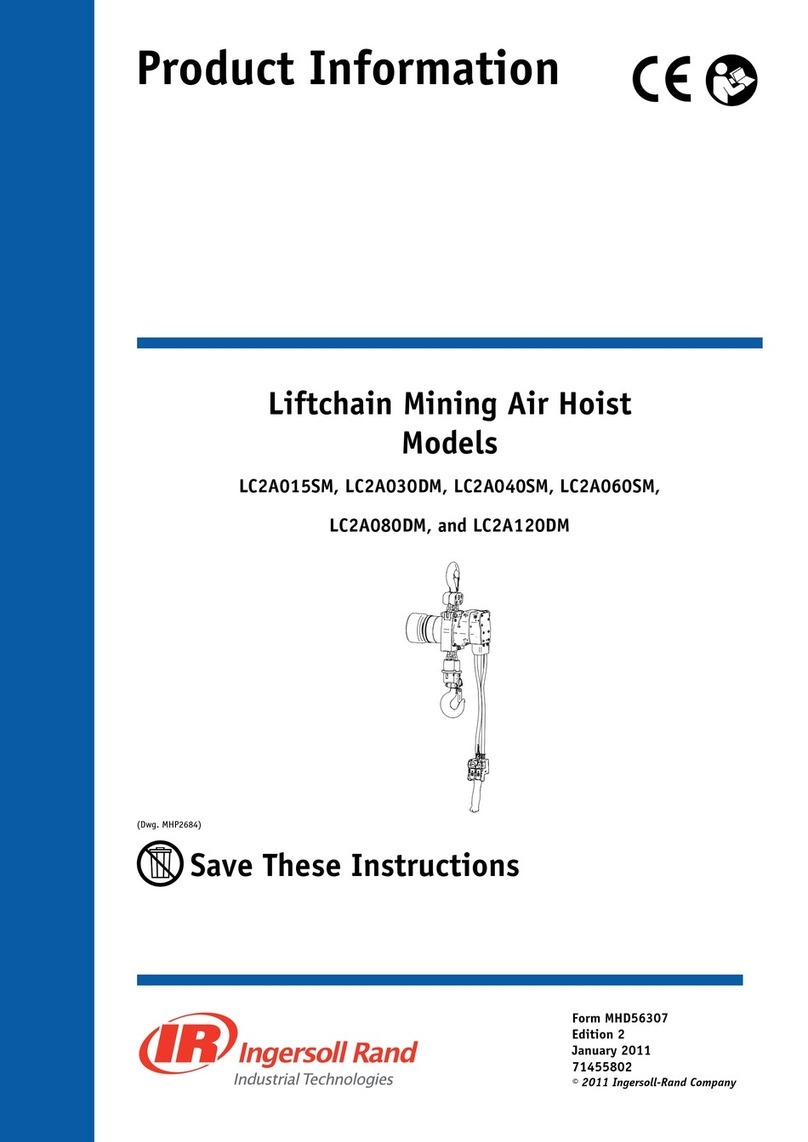
Ingersoll-Rand
Ingersoll-Rand LC2A015SM Product information
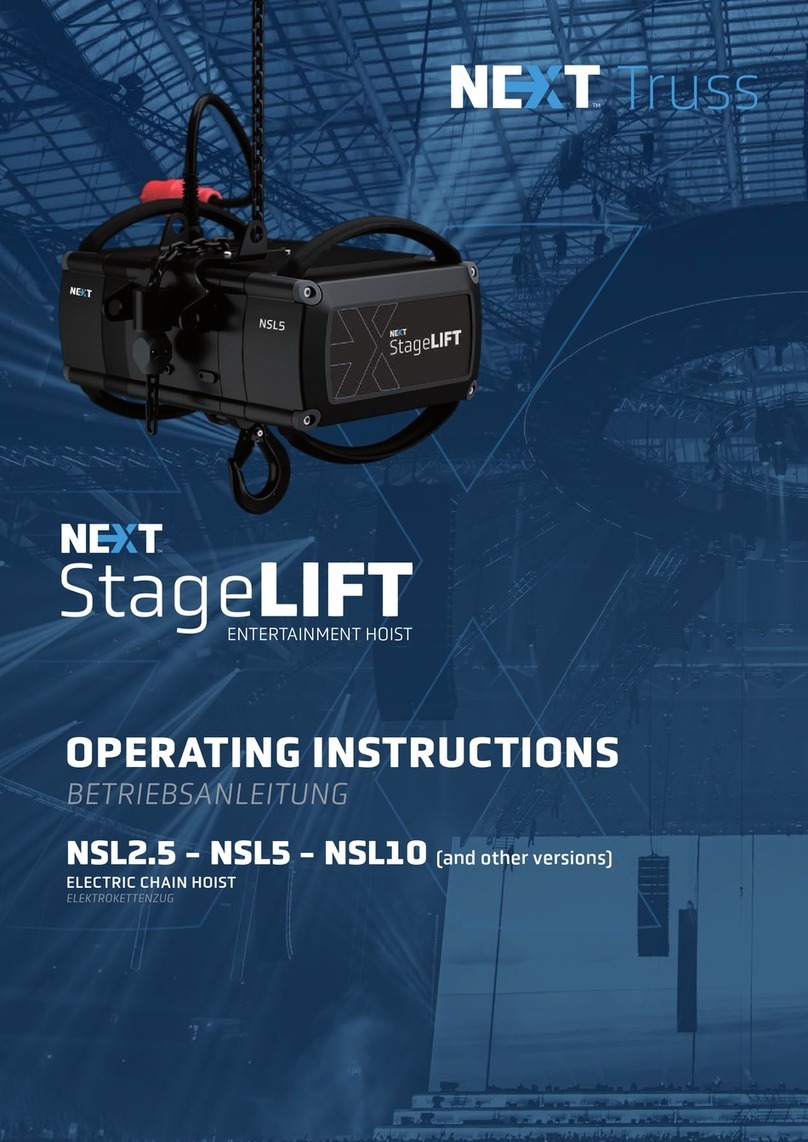
CMCO
CMCO NEXT Truss StageLIFT NSL2.5 operating instructions
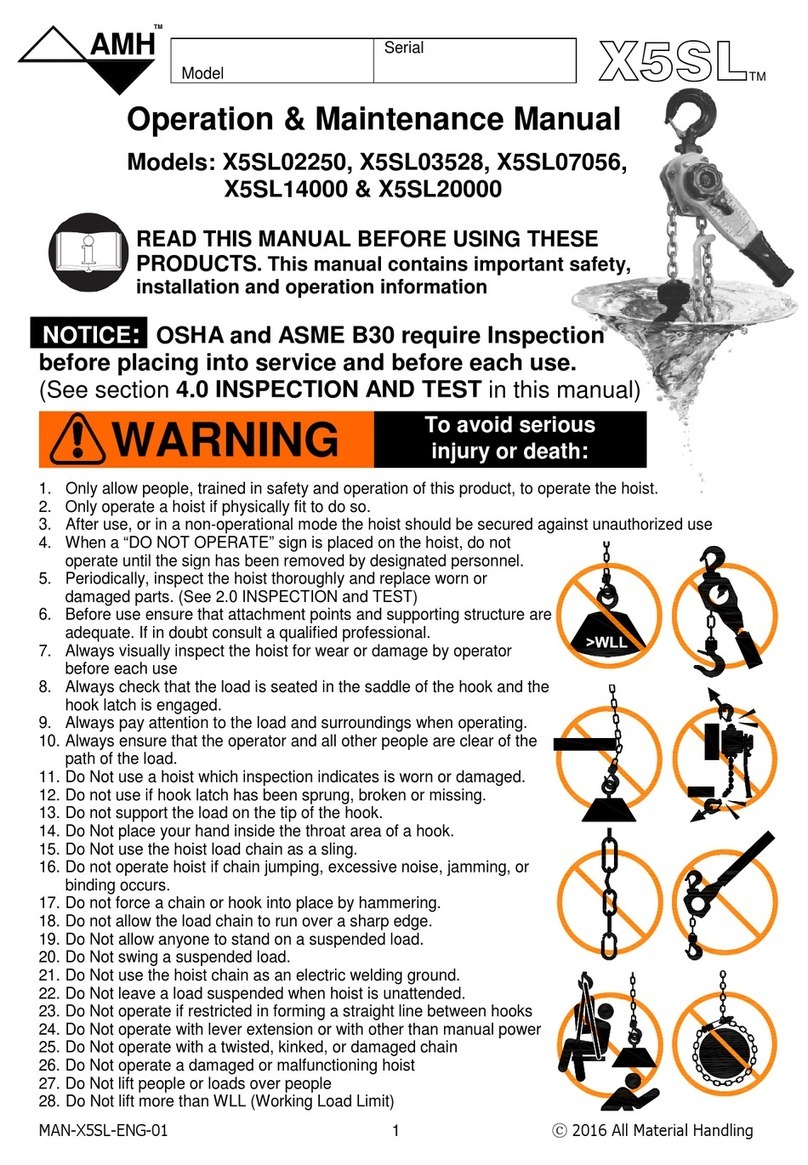
AMH
AMH X5SL02250 manual
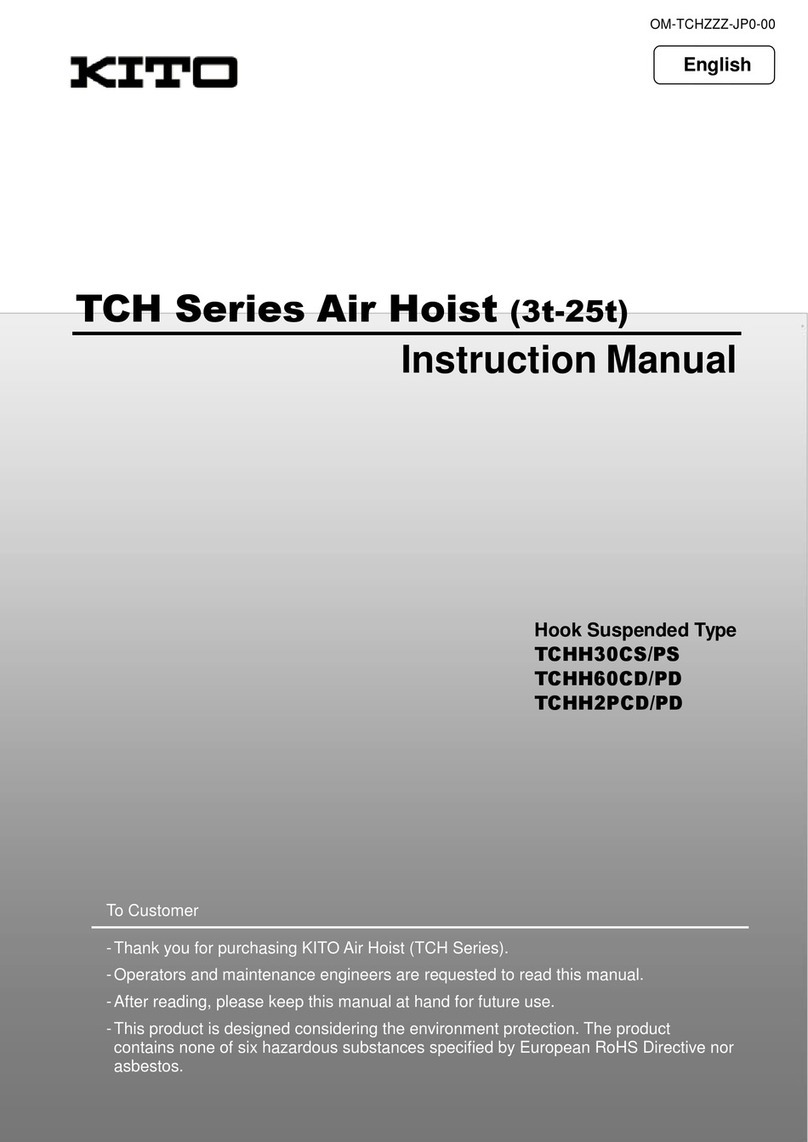
KITO
KITO TCH Series instruction manual
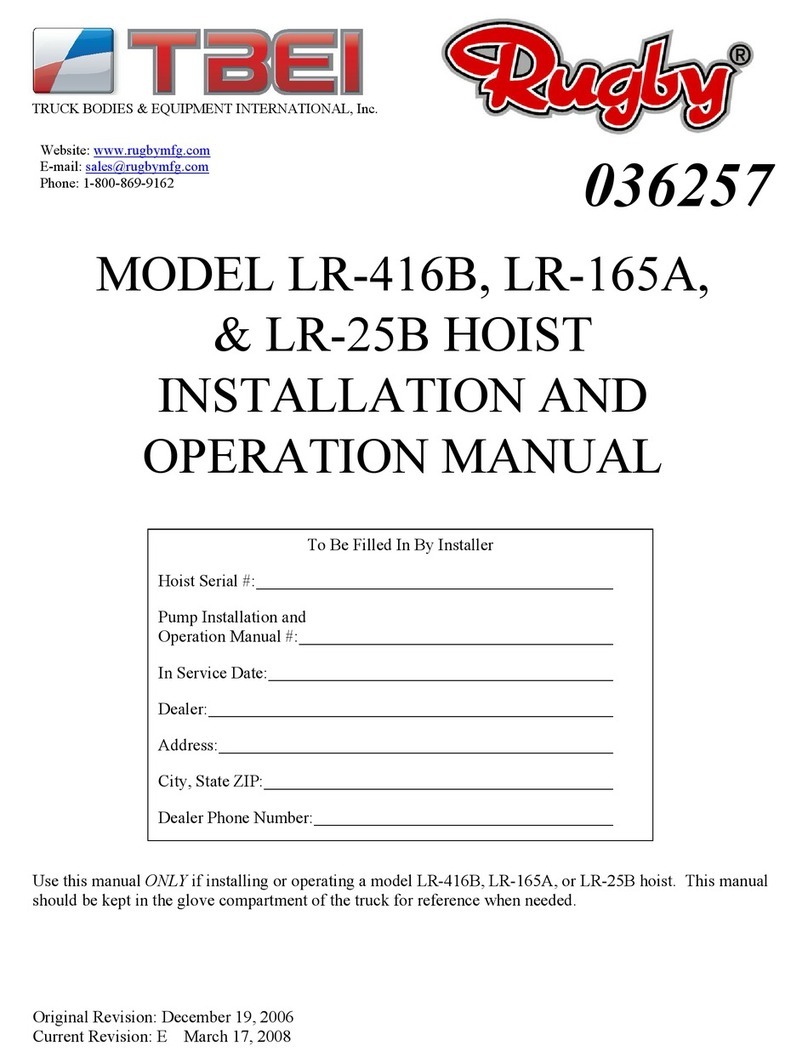
TBEI
TBEI Rugby LR-416B Installation and operation manual
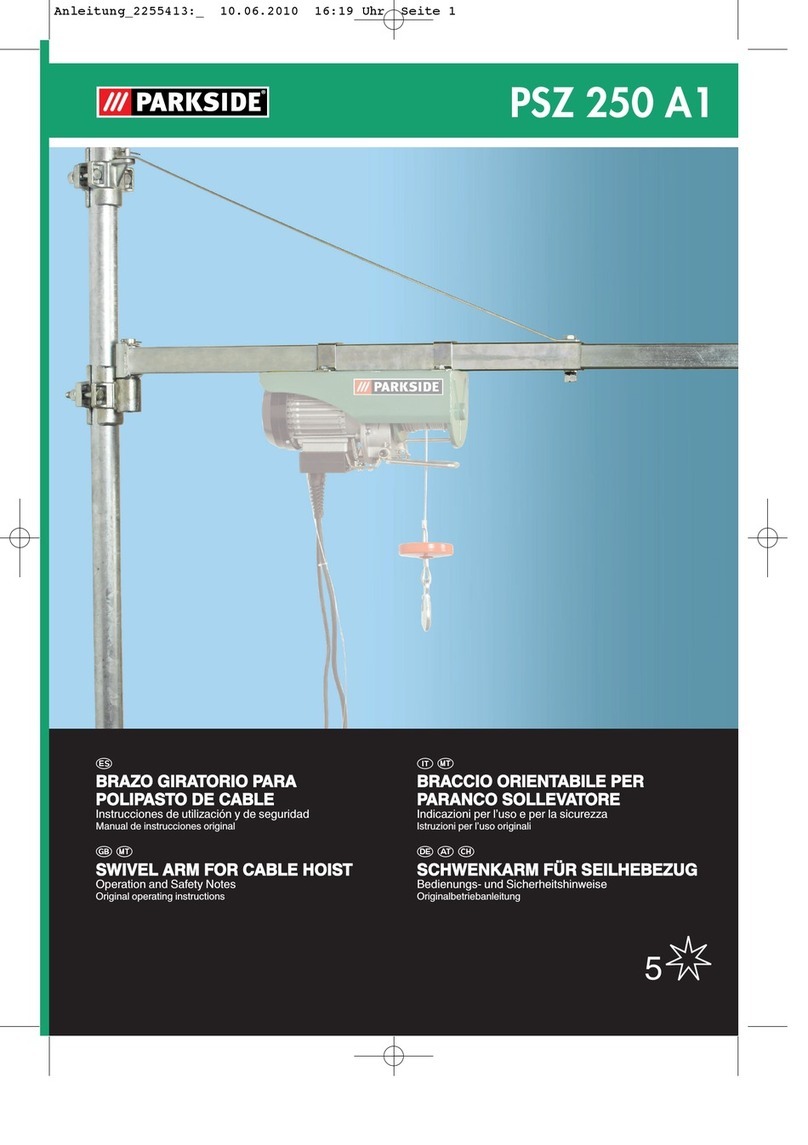
Parkside
Parkside PSZ 250 A1 operation and safety notes original operating instructions
